check engine CITROEN DS3 CABRIO 2014 Handbook (in English)
[x] Cancel search | Manufacturer: CITROEN, Model Year: 2014, Model line: DS3 CABRIO, Model: CITROEN DS3 CABRIO 2014Pages: 384, PDF Size: 11.85 MB
Page 7 of 384
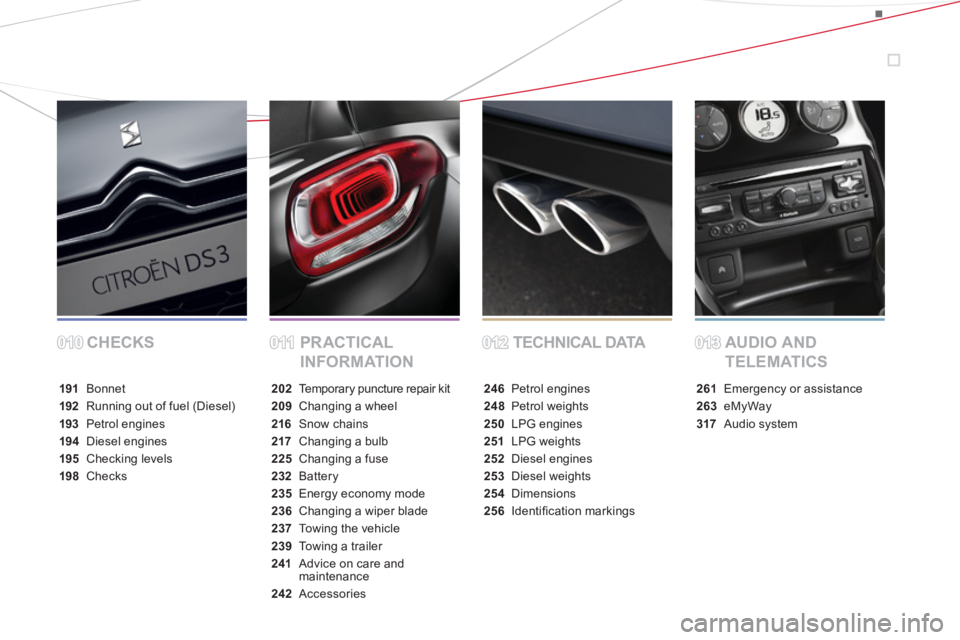
CHECKS PRACTICAL
INFORMATIONTECHNICAL DATA AUDIO AND
TELEMATICS
191Bonnet
192Running out of fuel (Diesel)
193Petrol engines
194 Diesel engines
195 Checking levels
198Checks
202Temporary puncture repair kit
209Changing a wheel
216 Snow chains
217 Changing a bulb
225 Changing a fuse
232Battery
235 Energy economy mode
236 Changing a wiper blade
237 Towing the vehicle
239To w i ng a trailer
241 Advice on care andmaintenance
242Accessories
246 Petrol engines
248 Petrol weights
250 LPG engines
251 LPG weights
252Diesel engines
253 Diesel weights
254 Dimensions
256 Identifi cation markings
261Emergency or assistance
263eMyWay
317 Audio system
012012013013010010011011
Page 27 of 384
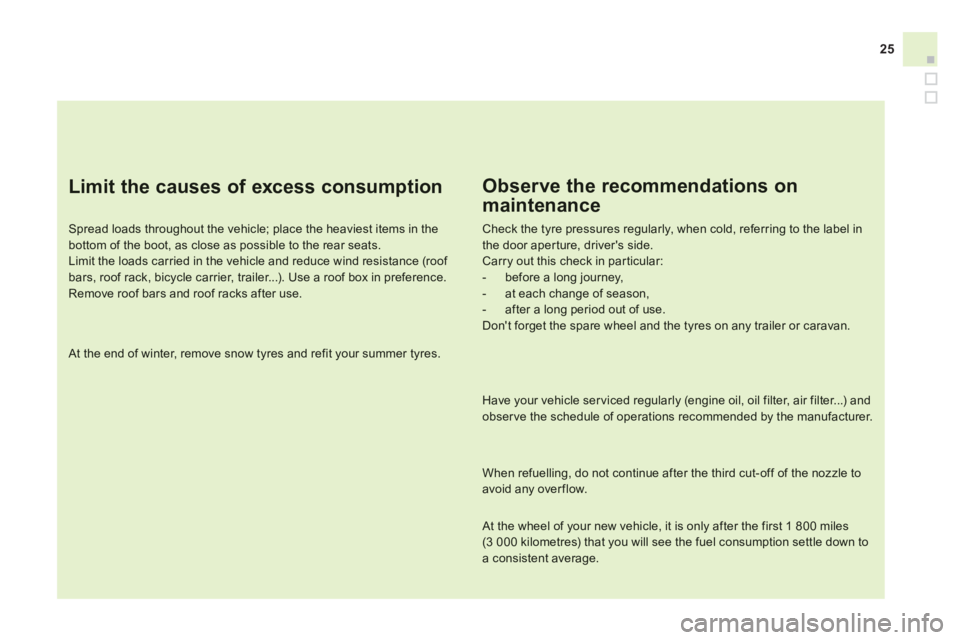
25
Limit the causes of excess consumption
Spread loads throughout the vehicle; place the heaviest items in the bottom of the boot, as close as possible to the rear seats.
Limit the loads carried in the vehicle and reduce wind resistance (roof bars, roof rack, bicycle carrier, trailer...). Use a roof box in preference.
Remove roof bars and roof racks after use.
At the end of winter, remove snow tyres and refit your summer tyres.
Observe the recommendations on
maintenance
Check the tyre pressures regularly, when cold, referring to the label inthe door aperture, driver's side.
Carry out this check in par ticular:
- before a long journey,
- at each change of season,
- after a long period out of use.
Don't forget the spare wheel and the tyres on any trailer or caravan.
Have your vehicle ser viced regularly (engine oil, oil filter, air filter...) andobser ve the schedule of operations recommended by the manufacturer.
When refuelling, do not continue after the third cut-off of the nozzle toavoid any over flow.
At the wheel of your new vehicle, it is only after the first 1 800 miles (3 000 kilometres) that you will see the fuel consumption settle down toa consistent average.
Page 39 of 384
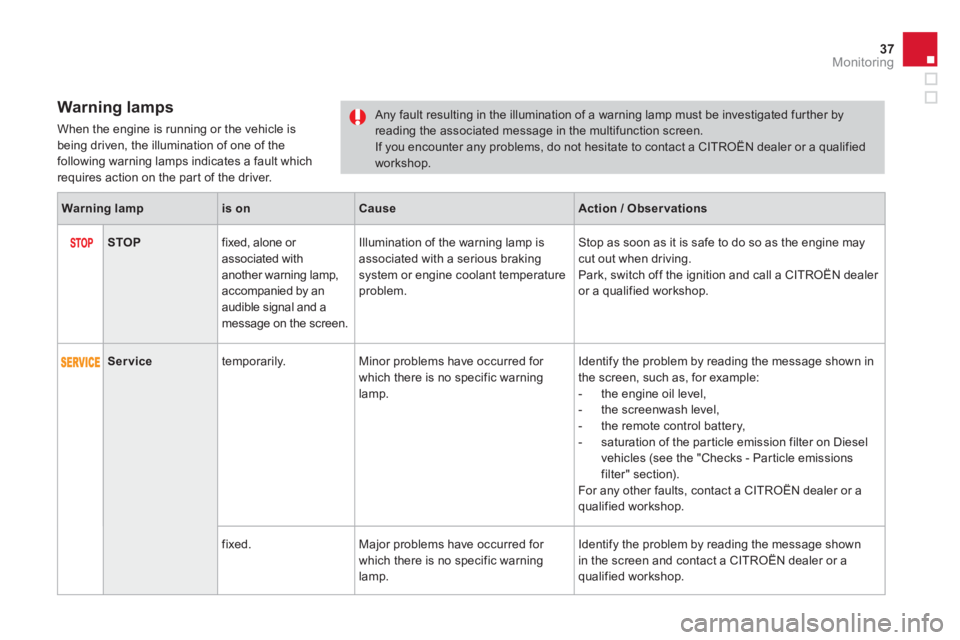
37
Monitoring
Warning lamps
When the engine is running or the vehicle is
being driven, the illumination of one of the following warning lamps indicates a fault which
requires action on the par t of the driver.
Any fault resulting in the illumination of a warning lamp must be investigated fur ther byreading the associated message in the multifunction screen.If you encounter any problems, do not hesitate to contact a CITROËN dealer or a qualified
workshop.
Warning lampis onCauseAction / Observations
STOPfixed, alone or associated with another warning lamp,accompanied by anaudible signal and amessage on the screen. Illumination o
f the warning lamp is
associated with a serious brakingsystem or engine coolant temperature
problem.
Stop as soon as it is safe to do so as the engine may cut out when driving.
Park, switch off the ignition and call a CITROËN dealer
or a qualified workshop.
Servicetemporarily. Minor problems have occurred for
which there is no specific warning lamp. Identi
fy the problem by reading the message shown in
the screen, such as, for example:
- the en
gine oil level,
- the screenwash level,
- the remote control batter
y,
- saturation of the par ticle emission filter on Diesel
vehicles (see the "Checks - Particle emissionsfilter" section).
For any other faults, contact a CITROËN dealer or a
qualified workshop.
fix
ed. Major problems have occurred for
which there is no specific warning lamp. Identif
y the problem by reading the message shownin the screen and contact a CITROËN dealer or a qualified workshop.
Page 41 of 384
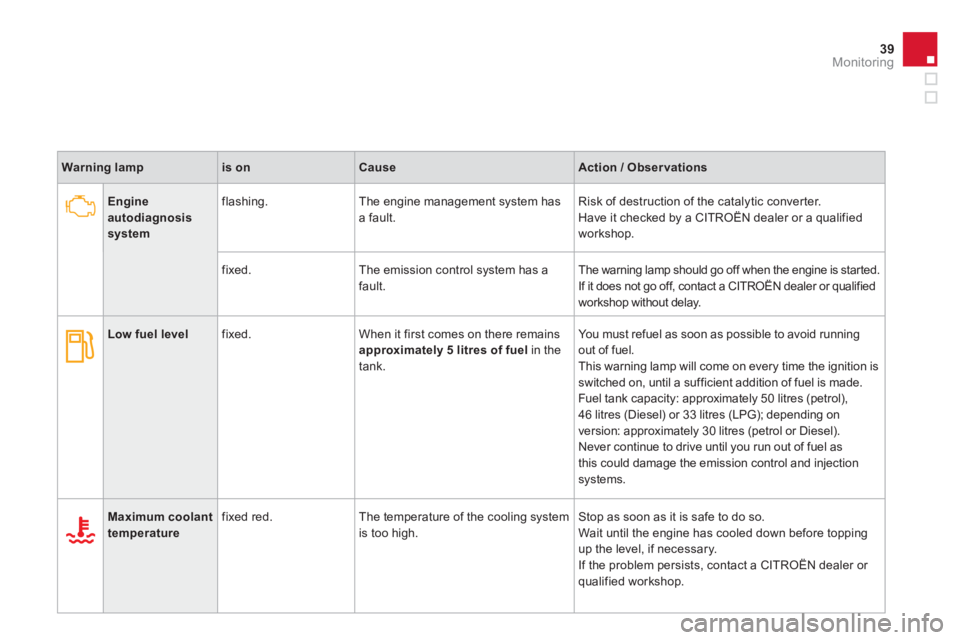
39Monitoring
Warning lampis onCauseAction / Observations
Engineautodiagnosis system
flashing. The engine management system has a fault.Risk of destruction of the catalytic conver ter.
Have it checked by a CITROËN dealer or a qualified workshop.
fixed. The emission control system has a fault.The warning lamp should go off when the engine is started.
If it does not go off, contact a CITROËN dealer or qualified workshop without delay.
Low fuel levelfixed. When it first comes on there remains approximately 5 litres offuelin thetank. You must refuel as soon as possible to avoid runnin
gout of fuel.
This warning lamp will come on every time the ignition is
switched on, until a sufficient addition of fuel is made.
Fuel tank capacity: approximately 50 litres (petrol),
46 litres (Diesel) or 33 litres (LPG); depending on
version: approximately 30 litres (petrol or Diesel).
Never continue to drive until you run out of fuel as
this could damage the emission control and injection
systems.
Maximum coolanttemperaturefixed red. The temperature of the cooling system is too high. Stop as soon as it is safe to do so.
Wait until the engine has cooled down before toppingup the level, if necessary.
If the problem persists, contact a CITROËN dealer or qualified workshop.
Page 43 of 384
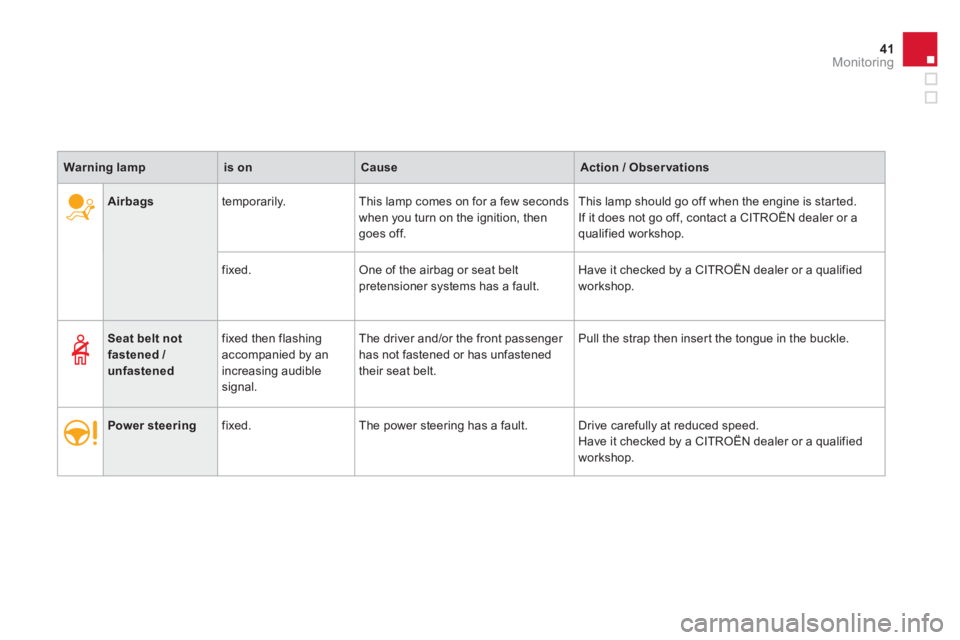
41Monitoring
Airbagstemporarily. This lamp comes on for a few seconds
when you turn on the ignition, then goes off. This lamp should
go off when the engine is started.
If it does not go off, contact a CITROËN dealer or aqualified workshop.
fixed. One of the airbag or seat belt
pretensioner systems has a fault. Have it checked by a CITROËN dealer or a qualified workshop.
Warning lampis onCauseAction / Observations
Seat belt notfastened / unfastenedfixed then flashin
gaccompanied by anincreasing audible
signal. The driver and/or the front passen
ger
has not fastened or has unfastened
their seat belt.Pull the strap then inser t the ton
gue in the buckle.
Power steeringfixed. The power steering has a fault. Drive carefully at reduced speed.
Have it checked b
y a CITROËN dealer or a qualified workshop.
Page 47 of 384
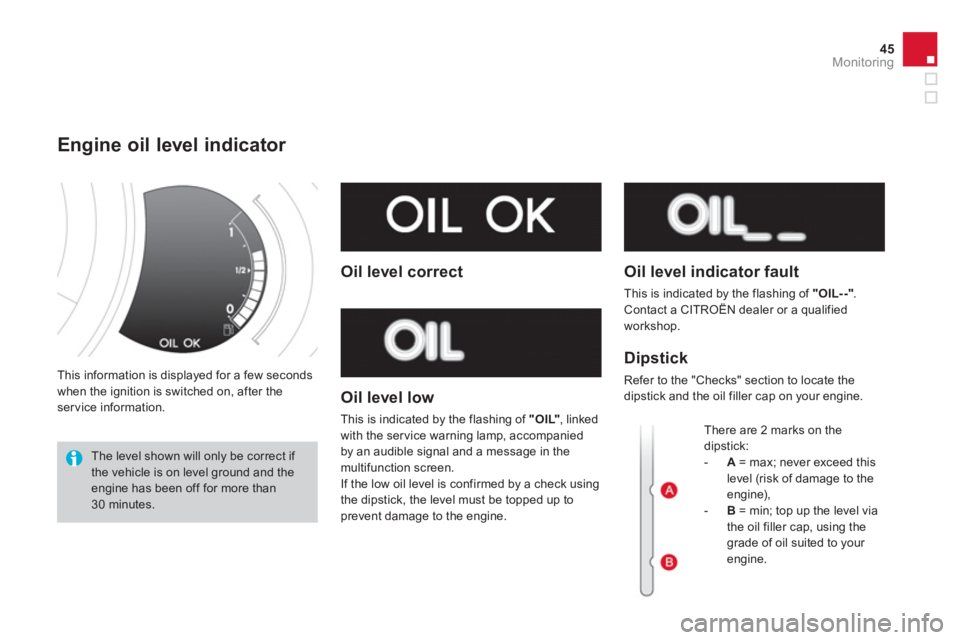
45
Monitoring
This information is displayed for a few seconds
when the ignition is switched on, after theservice information.
Engine oil level indicator
The level shown will only be correct if the vehicle is on level ground and the engine has been off for more than30 minutes.
Oil level correct
Oil level low
This is indicated by the flashing of "OIL", linked with the ser vice warning lamp, accompaniedby an audible signal and a message in themultifunction screen.
If the low oil level is confirmed by a check using
the dipstick, the level must be topped up to prevent damage to the engine.
Oil level indicator fault
This is indicated by the flashing of "OIL--"
. Contact a CITROËN dealer or a qualified
workshop.
Dipstick
Refer to the "Checks" section to locate the
dipstick and the oil filler cap on your engine.
Th
ere are 2 marks on thedipstick:-A= max; never exceed this
level (risk of damage to the engine), - B= min; top up the level via
the oil filler cap, using thegrade of oil suited to your engine.
Page 69 of 384
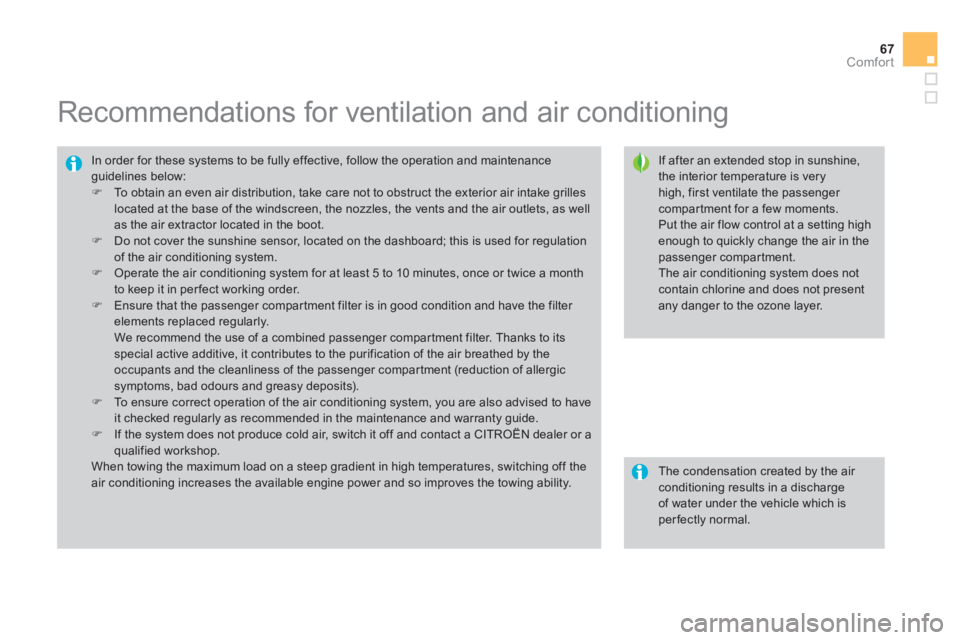
67
Comfort
Recommendations for ventilation and air conditioning
If after an extended stop in sunshine, the interior temperature is veryhigh, first ventilate the passenger compartment for a few moments. Put the air flow control at a setting high enough to quickly change the air in the passenger compartment.
The air conditioning system does notcontain chlorine and does not present any danger to the ozone layer.
In order for these systems to be fully effective, follow the operation and maintenance guidelines below: �)
To obtain an even air distribution, take care not to obstruct the exterior air intake grilles located at the base of the windscreen, the nozzles, the vents and the air outlets, as wellas the air extractor located in the boot. �)
Do not cover the sunshine sensor, located on the dashboard; this is used for regulation of the air conditioning system. �)
Operate the air conditioning system for at least 5 to 10 minutes, once or twice a monthto keep it in perfect working order. �)
Ensure that the passenger compar tment filter is in good condition and have the filter elements replaced regularly. We recommend the use of a combined passenger compar tment filter. Thanks to its special active additive, it contributes to the purification of the air breathed by theoccupants and the cleanliness of the passenger compartment (reduction of allergic symptoms, bad odours and greasy deposits).�)
To ensure correct operation of the air conditioning system, you are also advised to haveit checked regularly as recommended in the maintenance and warranty guide. �)
If the system does not produce cold air, switch it off and contact a CITROËN dealer or a qualified workshop.
When towing the maximum load on a steep gradient in high temperatures, switching off theair conditioning increases the available engine power and so improves the towing ability.
The condensation created by the air conditioning results in a dischargeof water under the vehicle which is perfectly normal.
Page 97 of 384
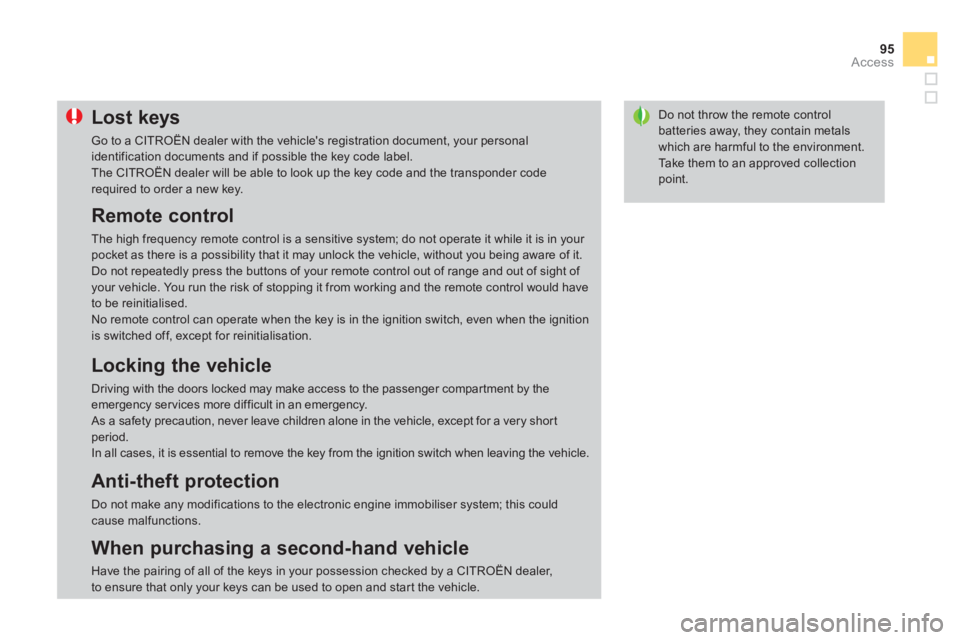
95
Access
Do not throw the remote control batteries away, they contain metalswhich are harmful to the environment.
Take them to an approved collectionpoint.
Lost keys
Go to a CITROËN dealer with the vehicle's registration document, your personalidentification documents and if possible the key code label.
The CITROËN dealer will be able to look up the key code and the transponder coderequired to order a new key.
Remote control
The high frequency remote control is a sensitive system; do not operate it while it is in your pocket as there is a possibility that it may unlock the vehicle, without you being aware of it.
Do not repeatedly press the buttons of your remote control out of range and out of sight of your vehicle. You run the risk of stopping it from working and the remote control would have to be reinitialised.
No remote control can operate when the key is in the ignition switch, even when the ignition is switched off, except for reinitialisation.
Locking the vehicle
Driving with the doors locked may make access to the passenger compar tment by the emergency ser vices more difficult in an emergency. As a safety precaution, never leave children alone in the vehicle, except for a very short period.
In all cases, it is essential to remove the key from the ignition switch when leaving the vehicle.
Anti-theft protection
Do not make any modifications to the electronic engine immobiliser system; this couldcause malfunctions.
When purchasing a second-hand vehicle
Have the pairing of all of the keys in your possession checked by a CITROËN dealer, to ensure that only your keys can be used to open and star t the vehicle.
Page 108 of 384
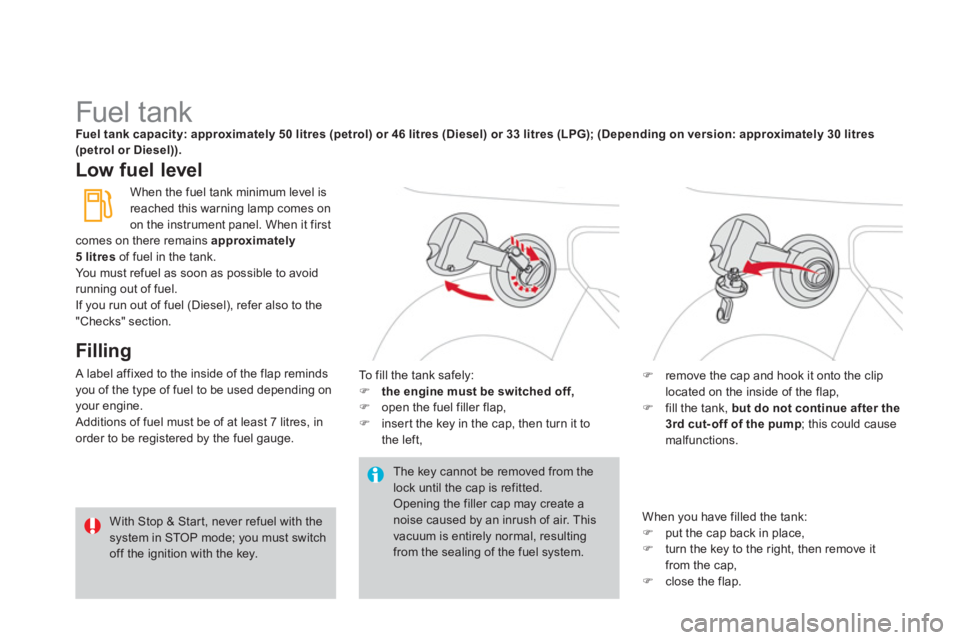
Fuel tank Fuel tank capacity: approximately 50 litres (petrol) or 46 litres (Diesel) or 33 litres (LPG); (Depending on version: approximately 30 litres (petrol or Diesel)).
Low fuel level
Fillin
g
A label affixed to the inside of the flap remindsyou of the type of fuel to be used depending onyour engine.
Additions of fuel must be of at least 7 litres, in
order to be re
gistered by the fuel gauge.
The key cannot be removed from the lock until the cap is refitted. Opening the filler cap may create a noise caused by an inrush of air. This vacuum is entirely normal, resultingfrom the sealing of the fuel system. To
fill the tank safely: �)the engine must be switched off,�)
open the fuel filler flap,�)
inser t the key in the cap, then turn it to
the left,
�)remove the cap and hook it onto the clip
located on the inside of the flap, �)fill the tank, but do not continue after the
3rd cut- off of the pump
; this could cause
malfunctions.
When
you have filled the tank:�)put the cap back in place,�)turn the key to the right, then remove it from the cap,�)close the flap. Wh
en the fuel tank minimum level is reached this warning lamp comes on
on the instrument panel. When it
firstcomes on there remains approximately 5 litres
of fuel in the tank.
You must refuel as soon as possible to avoid running out of fuel.
If you run out of fuel (Diesel), refer also to the
"Checks" section.
With Stop & Star t, never refuel with the system in STOP mode; you must switch off the ignition with the key.
Page 110 of 384
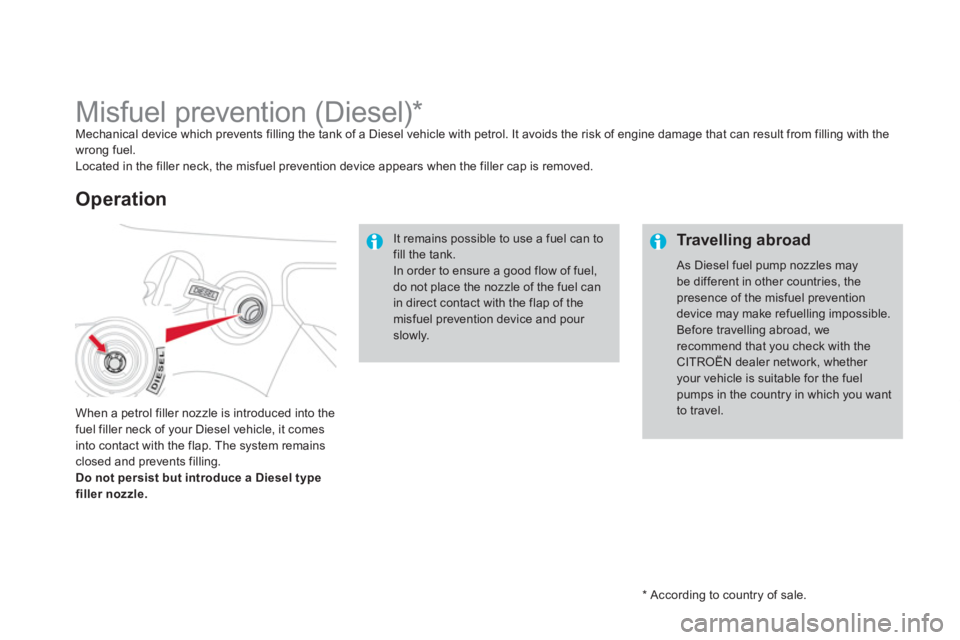
* According to country of sale.
Misfuel prevention (Diesel) * Mechanical device which prevents filling the tank of a Diesel vehicle with petrol. It avoids the risk of engine damage that can result from filling with the
wrong fuel.
Located in the
filler neck, the misfuel prevention device appears when the filler cap is removed.
Operation
When a petrol filler nozzle is introduced into the
fuel filler neck of your Diesel vehicle, it comes
into contact with the flap. The s
ystem remainsclosed and prevents filling.Do not persist but introduce a Diesel type filler nozzle.
It remains possible to use a fuel can to fill the tank. In order to ensure a good flow of fuel,do not place the nozzle of the fuel can in direct contact with the flap of the misfuel prevention device and pour slowly.
Tr a v e l l i ng abroad
As Diesel fuel pump nozzles maybe different in other countries, thepresence of the misfuel preventiondevice may make refuelling impossible.
Before travelling abroad, werecommend that you check with theCITROËN dealer network, whether your vehicle is suitable for the fuel pumps in the country in which you want to travel.